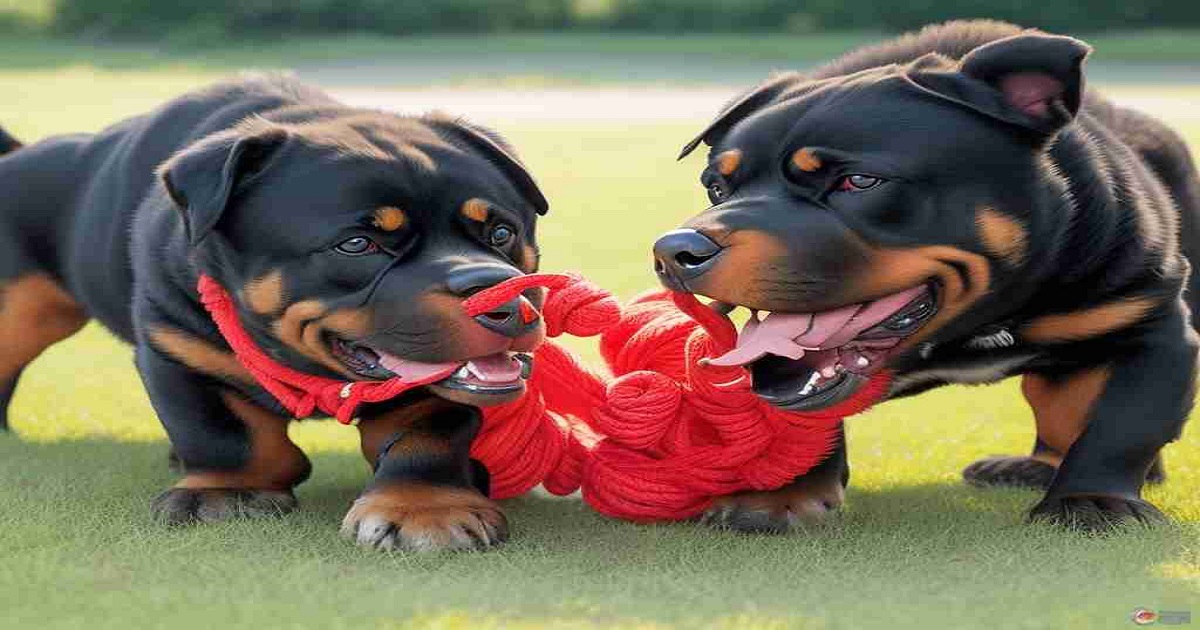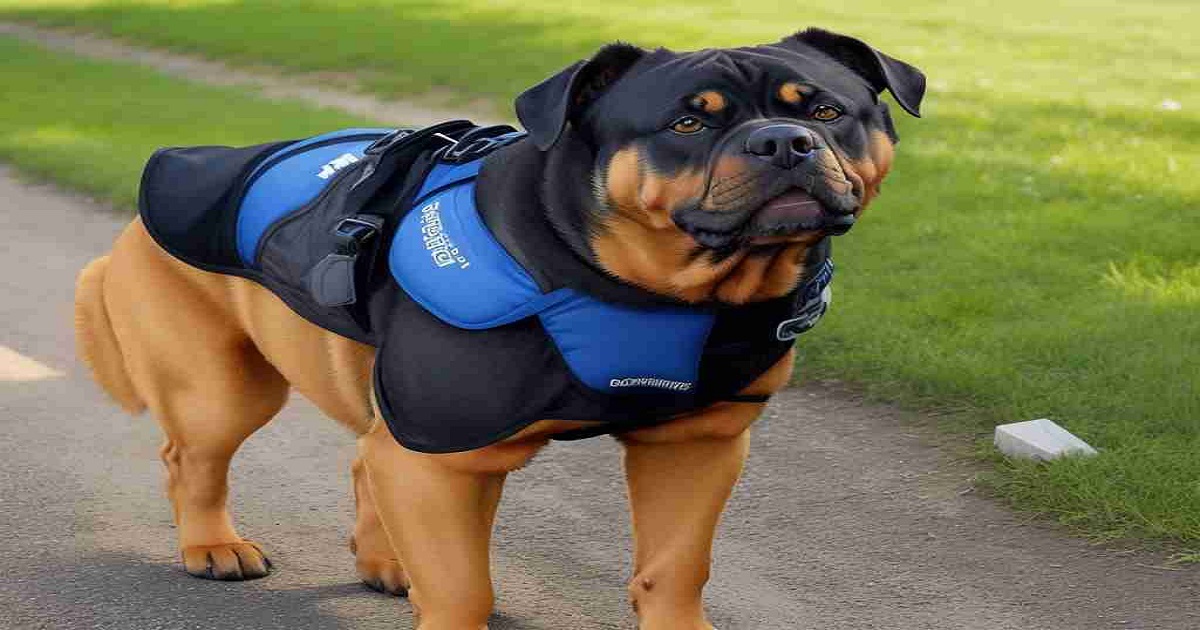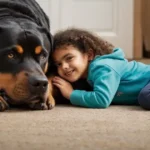Intrigued by the idea of a loyal guard dog that’s also a silly, sweet family companion? The Rottweiler Bulldog mix just might fit the bill. This relatively new hybrid dog breed combines the best traits of the standard Rottweiler and Bulldog.
Known as the Rottie-Bull or Bulldog Rott Mix, these medium-to-large crossbreeds are bursting with personality. Their stocky bodies pack plenty of power and endurance for outdoor adventures. Yet they love snuggling on the couch with their humans at the end of the day.
But is the Rottweiler crossed with Bulldog right for you? This in-depth guide will uncover everything you need to know before bringing one of these mixed breed dogs home.
We’ll explore crucial topics like:
- Rottie-Bull origins, history and breed standards
- Temperament, personality and exercise needs
- Training tips, grooming requirements and health concerns
- How to choose a breeder or rescue a Rottie-Bull
- Life expectancy and costs of ownership
Let’s start by understanding where Rottweiler Bulldog mixes come from and their typical physical traits.
Origins of the Rottie-Bull: A Brief History
Designer dogs like the Rottweiler Bulldog mix have grown in popularity over the last two decades. By crossing two purebreds, breeders aim to combine the best qualities of each lineage.
Rottie-Bulls are a modern hybrid without a long documented history. They likely first emerged in the 1990s or 2000s as part of the designer dog craze.
To better understand the Rottweiler Bulldog’s expected temperament and traits, let’s briefly cover the origins of each parent breed:
- Rottweilers descend from Roman drover dogs used to herd livestock. Their name comes from the German town of Rottweil. They were later utilized as guard dogs, draft animals and police dogs. Known for being alert, confident and responsive to training.
- Bulldogs trace back to 13th century England, where they were bred to bait bulls and guard property. Stocky build and fearless spirit enabled them to subdue bovine foes. Persistence led to popularity as lovable companions.
By mixing these two historic breeds, Rottie-Bull breeders aimed to develop dogs with the best qualities of both lineages.
What Does a Rottweiler Bulldog Mix Look Like?
Since Rottie-Bulls are a crossbreed, their appearance can vary quite a bit. Puppies from the same litter can look totally different!
In general, most Rottweiler Bulldog mixes weigh 55-100 lbs and stand 18-26 inches tall at the shoulder. They have a stocky, muscular build reminiscent of both parent breeds.
Coat colors run the gamut, but black, brown, tan and brindle are common. Rottie-Bull coats are short and smooth like the Bulldog parent. The Rottweiler genes give them a dense, sleek top coat.
Facial features are a mosaic of Bulldog and Rottweiler traits. Most have a slightly brachycephalic (shortened) muzzle like Bulldogs. The head is broad with a defined stop and strong jaws. Loose neck skin and dewlaps give that classic Bulldog wrinkly look.
Rottweiler attributes include dark almond-shaped eyes, triangular floppy ears and a black nose. The eyes convey a serious, alert expression.
Gait and Build: Sturdy and Powerful
The Rottie-Bull cut combines strength and agility. Their sturdy, thickset frame packs plenty of power for their medium-large size.
Muscular hindquarters and a broad chest give them an athletic, flexible gait. Their relatively short legs carry a rotund torso just above the ground. Sturdy bone structure and padded feet make them shockingly nimble and fast.
Front legs set wide apart confer stability and balance. Fluid movement suits them well to canine sports like agility.
Don’t let the stocky build fool you – Rottie-Bulls need plentiful exercise! We’ll cover their activity requirements shortly. First, let’s explore their expected temperament and personality.
Inside the Mind of a Rottweiler Bulldog Mix
With any mixed breed, temperament will vary greatly depending on which parent traits are inherited. Environment and training play pivotal roles as well.
Certain characteristics are common across well-bred Rottweiler and Bulldog crossbreeds:
- Intelligent but stubborn at times
- Confident and courageous
- Energetic yet loves lounging with family
- Wary of strangers but friendly if socialized early
- Devoted and loyal, bonds strongly with “pack”
- Protective instincts make great watchdogs
- Respond well to firm, positive training
- Gentle and patient with children if raised with kids
Proper socialization and training will nurture the Rottie-Bull’s natural guardian instincts while curbing unwanted aggression.
Early obedience classes are highly recommended to establish control and manners. Rottweiler Bulldog puppies should be exposed to a wide variety of people, places and situations.
This helps counteract wariness toward strangers and overreactivity. Continued socialization into adulthood prevents territorial behaviors.
With early guidance and boundaries, the Rottie-Bull really shines as a courageous yet controllable family guardian.
Exercise & Training Needs of the Rottweiler Bulldog Mix
Rottie-Bulls have impressive endurance thanks to their working breed backgrounds. They demand a committed owner willing to provide ample daily activity.
At minimum, Rottweiler Bulldog mixes need 60+ minutes of vigorous exercise every day. They particularly love interactive play that challenges their body and mind.
Recommended activities for a well-exercised Rottie-Bull include:
- Long walks or jogging with their person – they make great running partners!
- Playing fetch or frisbee in an open field or park
- Swimming – great low-impact exercise for their joints
- Agility training like weave poles and jumps
- Treibball – chasing and herding large fitness balls
- Backpacking and hiking outdoors with rest periods
- Canine sports such as dock diving, flyball or obedience trials
- Tug of war or flirt pole chasing games
Mental stimulation is equally important to prevent boredom. Food puzzle toys, snuffle mats and training sessions will keep their active brains engaged.
Without sufficient activity, Rottweiler Bulldog mixes become restless and destructive. Weight gain is another serious risk. Overweight Rottie-Bulls struggle with joint problems, breathing issues and heat intolerance.
Focus training and impulse control are other key areas to work on. The intelligence and drive of Rottweiler and Bulldog mixes make them very trainable. But they can be headstrong, demanding a confident pack leader.
Early socialization lays the foundation for a well-mannered companion. Consistent positive reinforcement keeps an adult Rottie-Bull engaged and obedient.
Grooming Needs of the Rottweiler Bulldog Cross
Thanks to their short, sleek coat, Rottie-Bulls only need moderate grooming. Weekly brushing removes dead hair and distributes skin oils.
Bathing every 1-2 months with a gentle dog shampoo keeps their coat clean and shiny. Rinse thoroughly as residue can irritate skin.
Other routine grooming tasks include:
- Nail trimming every 2-3 weeks
- Teeth brushing 2-3 times per week
- Ear cleaning once a week – wrinkly folds trap moisture
- Facial wrinkle care – gently clean deep folds and apply powder/ointment
Shedding can be heavy a few times per year during seasonal coat blowouts. Regular brushing helps control loose fur. Anundercoat rake helps remove the undercoat before it sheds.
Some drooling is expected with their loose flews. Keeping facial wrinkles clean prevents irritation and infection in skin folds.
Overall the Rottweiler Bulldog mix has manageable grooming needs well-suited to most owners.
Health Concerns Common in Rottweiler Bulldog Mixes
All dogs have genetic risks, including designer breeds like the Rottie-Bull. Crossbreeding can reduce the chances of inheriting certain diseases. But health issues from both parental lines are still possible.
Potential health problems to watch for include:
- Joint dysplasia – Malformed hips and elbows. Causes arthritis and lameness. Weight control and joint supplements help.
- Brachycephalic Syndrome – Breathing issues and heat sensitivity. Limit exercise in hot/humid weather.
- Heart conditions – Subaortic stenosis and cardiomyopathy occur in some lines. Annual vet exams recommended.
- Allergies – Food allergies cause skin and ear issues. Try elimination diets if symptoms arise.
- Bloat – Rotties prone to deadly gastric torsion. Prevent with slow feed bowl and rest after eating.
With purebreds, health testing the parents screens for genetic conditions. Ask breeders for proof of health clearances.
Adopted Rottie-Bulls may have unknown backgrounds. So watch closely for developing issues and discuss risks with your vet.
What is the Life Expectancy of a Rottweiler Bulldog Mix?
With proper care, the average life expectancy is 10-12 years. Some may live a few years longer.
Maximizing longevity involves:
- Choosing physically sound, health-tested parents
- Maintaining lean body weight
- Providing vet care as recommended
- Spay/neuter to reduce cancer risks
- Planning breed-appropriate exercise and nutrition
- Training bite inhibition and avoiding overexertion
Highly active Rottie-Bulls kept lean and fit tend to outlive their inactive counterparts. Follow your vet’s advice to catch issues early and control preventable conditions like obesity.
Finding a Rottweiler Bulldog Mix Puppy or Rescue
Decided the Rottie-Bull is the perfect pooch for your family? Here are responsible places to find one:
Check shelters and rescue groups first – Adoption fees typically range from $50 to $500. You’re giving an adult or puppy Rottie-Bull a second chance at a forever home. Rescues often cover initial vet care too.
AKC Marketplace – Search for approved breeders with available Rottweiler Bulldog mix puppies. Expect to pay $1000 or more. Ask about parent health testing.
Google search – Enter your location + “Rottweiler Bulldog mix breeders” to find options. Vet potential breeders thoroughly. Visit facilities and meet parents if possible.
Puppies for sale websites– Use caution as many breeders on these sites are irresponsible. Meet breeders and pups in person before purchasing.
Avoid pet stores and backyard breeders with no health testing. Be very wary of unusually low “bargain” prices, as this signals unethical breeding.
Questions to Ask Breeders or Adoption Groups
Responsible sources will happily answer any of these questions:
- What health tests were performed on the parents? Ask to see veterinary records.
- How have the puppies/dogs been socialized so far?
- What is the temperament of each parent like? Are there any behavioral concerns?
- How many litters has the mother had? More than 5 litters often indicates excessive breeding.
- Can I meet the puppy’s parents in person? Assess their friendliness and appearance.
- Do you have references from people who adopted one of your Rottie-Bull puppies? Can I contact them?
- What is included with the adoption/purchase fee such as vet records, food samples, health guarantee?
Visiting the breeder’s home or kennel provides essential clues. Puppies and facilities should be clean, safe and sanitary. Well-socialized parent dogs indicate responsible breeding practices.
Red flags include fearful puppies, unsafe conditions, no health testing or guarantees. Keep looking if anything seems off.
Initial Costs of Owning a Rottweiler Bulldog Mix
Beyond the adoption fee or purchase price, owning a Rottie-Bull carries expenses. Here are estimated first year costs:
- Adoption fee or purchase price: $50 to $1500+
- Supplies: Leash, collar, crate, bowls, toys etc = $150 – $500
- Initial vet visit with vaccinations, testing = $300 – $700
- Spay/neuter surgery = $100-$500
- Training costs = $100 – $800+
- Food, treats, vitamins = $400 – $1000
- Grooming supplies, nail clippers etc = $50 – $150
Total initial costs = Approximately $1500 – $5000+
This spends down significantly after the first year. But ongoing costs persist for food, routine vet care, supplies and miscellaneous expenses.
Is the Rottweiler Bulldog Mix the Right Dog For You?
Before welcoming a Rottie-Bull into your home, reflect on these key considerations:
- Rottweiler Bulldog mixes need extensive activity each day or they become restless and destructive. Do you have time for long daily walks, hikes, runs or dog sports?
- They excel with experienced dog owners able to provide structured leadership, training and socialization. First time owners may struggle.
- Rottie-Bulls can be wary of strangers and need continued socialization. Are you prepared to have guests meet your dog safely?
- Potential health risks like joint problems must be budgeted for. Can you manage vet bills?
- Breed bans exist in some areas. Ensure Rottie-Bulls are permitted where you live.
- Their size and strength require caution around young kids. Supervise carefully.
If an active lifestyle, training commitment and strong leadership come naturally, the good-natured Rottie-Bull will thrive in your capable hands.
Next Steps After Deciding to Get a Rottweiler Bulldog Mix
Ready to add a Rottie-Bull to your home? Here are key next steps:
- Research breeders, rescues and shelters in your area and submit adoption applications where permitted.
- Puppy-proof your home including electrical cords, poisonous plants, medications, etc. Secure backyards.
- Buy essential supplies like a crate, leash/collar, food bowls, bed and toys. Stock up on puppy food.
- Find a trusted vet and schedule puppy wellness exams.
- Look for puppy kindergarten and obedience classes to enroll in.
- Dog-proof your vehicle with a secure crate or restraint.
- Create a budget for annual costs like food, routine vet care, preventatives, training, boarding etc.
- Tell your neighbors you’ll be welcoming a Rottie-Bull. Give them tips to interact safely.
- Prepare family members for the new routine including potty breaks, exercise, training and adjusting periods.
- Puppy-proof your schedule and lifestyle to ensure you can dedicate ample time to training and exercising your Rottie-Bull daily.
- Stock your pantry and freezer with healthy treats and chews to support training.
Once preparations are complete, it will be time to welcome your Rottie-Bull home! The first weeks are crucial for potty training and bonding. Enjoy this special time.
Frequently Asked Questions About the Rottweiler Bulldog Mix
Deciding if the Rottie-Bull is the right breed for you? Here are answers to some common questions:
Are Rottweiler Bulldog mixes good family dogs?
Yes, with proper training and socialization from a young age, Rottie-Bulls can be wonderful family companions. Early exposure to children is ideal. Supervise young kids to prevent rough play.
Do Rottie-Bulls get along with other pets?
They tend to be dog-friendly if socialized early on. Feline and small pet interactions should be supervised. Their high prey drive can kick in if a cat or small pet runs.
How much exercise does a Rottweiler Bulldog mix need daily?
Plan on at least 60 minutes of vigorous activity like running, hiking, swimming or training each day. Puppies under 2 years may need a few shorter sessions.
What health issues are common in Rottweiler Bulldog mixes?
Joint dysplasia, cardiac conditions, allergies, bloat and brachycephalic syndrome are potential concerns. Buying from health-tested parents reduces risk.
Are Rottweiler Bulldog mixes easy to train?
Yes, they are very intelligent and aim to please their owners. Use positive reinforcement and be a consistent, firm pack leader. Seek professional training if struggling.
What type of home is best for a Rottie-Bull?
Active owners who can properly exercise, train and socialize them. Homes with securely fenced yards. Experience with strong guardian breeds is a plus.
How often should I groom my Rottweiler Bulldog mix?
Plan on brushing their short coat 1-2 times per week. Bathing every 1-2 months. Trim nails, clean ears and wrinkles as needed. More frequent grooming during shedding seasons.
The Rottweiler Bulldog Mix: Final Thoughts
Rottie-Bulls aren’t the right match for everyone. Their high exercise needs, powerful build and stubborn streak demand an experienced owner. Proper training and socialization are paramount.
But in the right hands, these brave, lovable mixed breeds flourish. Their playful charm and steadfast devotion make the effort worthwhile.
If you can provide the firm guidance, activity and healthcare a Rottweiler Bulldog mix needs, you’ll gain a loyal companion for life. Just be sure to choose responsibly and set your puppy up for success from the start.










1 thought on “Rottweiler Bulldog Mix: The Perfect Family Guardian Dog?”